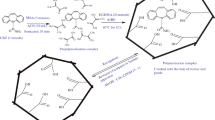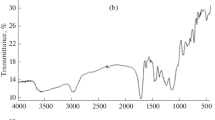Abstract
Two molecularly imprinted polymers (MIPs) were synthesized according to a previous work from our group dealing with the extraction of carbamazepine from environmental water. The potential of these MIPs, which differ in the nature of the monomer used for their synthesis, to selectively extract the drugs carbamazepine and oxcarbazepine and the metabolite 10,11-epoxycarbamazepine was first studied in spiked pure water, and high selectivity was obtained with both MIPs for the three target molecules in this pure medium. This selectivity was maintained when applying one of the MIPs to urine samples. Indeed, extraction recoveries were higher than 82% on the MIP and lower than 20% on the corresponding non-imprinted polymer used as a control. The repeatability of the extraction procedure applied to urine was also demonstrated, with relative standard deviation (RSD) below 20% for extraction recoveries of the three targets at a spiking level of 20 ng L−1. Limits of quantification between 1 and 7 ng L−1 were determined for urine samples using the MIP as extraction sorbent combined with LC–MS analysis. The potential of the MIP was compared to that of the Oasis HLB sorbent. This study shows that the MIP constitutes a powerful tool for avoiding matrix effects encountered in the quantification of the target molecules in urine samples extracted on Oasis HLB.



Similar content being viewed by others
References
Brezina E, Prasse C, Meyer J et al (2017) Investigation and risk evaluation of the occurrence of carbamazepine, oxcarbazepine, their human metabolites and transformation products in the urban water cycle. Environ Pollut 225:261–269. https://doi.org/10.1016/j.envpol.2016.10.106
Datar PA (2015) Quantitative bioanalytical and analytical method development of dibenzazepine derivative, carbamazepine: a review. J Pharm Anal 5:213–222. https://doi.org/10.1016/j.jpha.2015.02.005
Fedorova G, Ben Ari J, Tadmor G et al (2016) Environmental exposure to pharmaceuticals: a new technique for trace analysis of carbamazepine and its metabolites in human urine. Environ Pollut 213:308–313. https://doi.org/10.1016/j.envpol.2016.02.027
Chen S-Y, Wen-Chi C, Sarah C Y (2018) Cyclodextrin-assisted dispersive liquid–liquid microextraction for the preconcentration of carbamazepine and clobazam with subsequent sweeping micellar electrokinetic chromatography. J Sep Sci 41:1871–1879. https://doi.org/10.1002/jssc.201701096
Zhang R, Wang S, Yang Y et al (2018) Modification of polydopamine-coated Fe3O4 nanoparticles with multi-walled carbon nanotubes for magnetic-mu-dispersive solid-phase extraction of antiepileptic drugs in biological matrices. Anal Bioanal Chem 410:3779–3788. https://doi.org/10.1007/s00216-018-1047-1
Behbahani M, Najafi F, Bagheri S et al (2013) Application of surfactant assisted dispersive liquid–liquid microextraction as an efficient sample treatment technique for preconcentration and trace detection of zonisamide and carbamazepine in urine and plasma samples. J Chromatogr A 1308:25–31. https://doi.org/10.1016/j.chroma.2013.07.088
Beltran A, Caro E, Marce RM et al (2007) Synthesis and application of a carbamazepine-imprinted polymer for solid-phase extraction from urine and wastewater. Anal Chim Acta 597:6–11
Beltran A, Marcé RM, Cormack PAG, Borrull F (2009) Synthesis by precipitation polymerisation of molecularly imprinted polymer microspheres for the selective extraction of carbamazepine and oxcarbazepine from human urine. J Chromatogr A 1216:2248–2253
Dai C, Geissen S-U, Zhang Y et al (2010) Performance evaluation and application of molecularly imprinted polymer for separation of carbamazepine in aqueous solution. J Hazard Mater 184:156–163. https://doi.org/10.1016/j.jhazmat.2010.08.018
Esfandyari-Manesh M, Mehran J, Fatemeh A et al (2011) Effect of porogenic solvent on the morphology, recognition and release properties of carbamazepine-molecularly imprinted polymer nanospheres. J Appl Polym Sci 121:1118–1126. https://doi.org/10.1002/app.33812
Mehran Esfandyari-ManeshMJavanbakht, Fatemeh A, Dinarvand Rassoul (2012) Synthesis and evaluation of uniformly sized carbamazepine-imprinted microspheres and nanospheres prepared with different mole ratios of methacrylic acid to methyl methacrylate for analytical and biomedical applications. J Appl Polym Sci 125:1804–1813. https://doi.org/10.1002/app.36288
Esfandyari-Manesh M, Javanbakht M, Dinarvand R, Atyabi F (2012) Molecularly imprinted nanoparticles prepared by miniemulsion polymerization as selective receptors and new carriers for the sustained release of carbamazepine. J Mater Sci Mater Med 23:963–972. https://doi.org/10.1007/s10856-012-4565-y
Dai C, Zhang J, Zhang Y et al (2013) Removal of carbamazepine and clofibric acid from water using double templates–molecularly imprinted polymers. Environ Sci Pollut Res 20:5492–5501. https://doi.org/10.1007/s11356-013-1565-5
Zhang Y-L, Zhang J, Dai C-M et al (2013) Sorption of carbamazepine from water by magnetic molecularly imprinted polymers based on chitosan-Fe3O4. Carbohydrate Polym 97:809–816. https://doi.org/10.1016/j.carbpol.2013.05.072
Lee J-C, Kim C-R, Byun H-S (2014) Synthesis and adsorption properties of carbamazepine imprinted polymer by dispersion polymerization in supercritical carbon dioxide. Korean J Chem Eng 31:2266–2273. https://doi.org/10.1007/s11814-014-0178-0
Khalilian Faezeh A Setareh (2016) Molecularly imprinted polymer on a SiO2-coated graphene oxide surface for the fast and selective dispersive solid-phase extraction of carbamazepine from biological samples. J Sep Sci 39:1500–1508. https://doi.org/10.1002/jssc.201501392
Asgari S, Bagheri H, Es-haghi A, AminiTabrizi R (2017) An imprinted interpenetrating polymer network for microextraction in packed syringe of carbamazepine. J Chromatogr A 1491:1–8. https://doi.org/10.1016/j.chroma.2017.02.033
Khadirvel P, Combès A, Bordron L, Pichon V (2018) Rational designing and development of water compatible molecularly imprinted polymers for the selective extraction of carbamazepine from environmental waters (submitted)
Fortuna A, Sousa J, Alves G et al (2010) Development and validation of an HPLC-UV method for the simultaneous quantification of carbamazepine, oxcarbazepine, eslicarbazepine acetate and their main metabolites in human plasma. Anal Bioanal Chem 397:1605–1615. https://doi.org/10.1007/s00216-010-3673-0
Neumann J, Beck O, Dahmen N, Böttcher M (2018) Potential of oral fluid as a clinical specimen for compliance monitoring of psychopharmacotherapy. Ther Drug Monit 40:245. https://doi.org/10.1097/FTD.0000000000000493
Acknowledgements
This work was supported by the French National Research Agency (ANR Program: ANR-15-CE04-0012, project MIP_WQT).
Author information
Authors and Affiliations
Corresponding author
Ethics declarations
Conflict of interest
The authors declare that they have no conflict of interest.
Research involving human participants and/or animals
Informed consent was obtained from all individual participants included in this study.
Additional information
Publisher’s Note
Springer Nature remains neutral with regard to jurisdictional claims in published maps and institutional affiliations.
Published in Chromatographia’s 50th Anniversary Commemorative Issue.
Rights and permissions
About this article
Cite this article
Combes, A., Kadhirvel, P., Bordron, L. et al. Synthesis and Characterization of Molecularly Imprinted Polymers for the Selective Extraction of Carbamazepine and Analogs from Human Urine Samples. Chromatographia 82, 287–295 (2019). https://doi.org/10.1007/s10337-018-3680-4
Received:
Revised:
Accepted:
Published:
Issue Date:
DOI: https://doi.org/10.1007/s10337-018-3680-4




